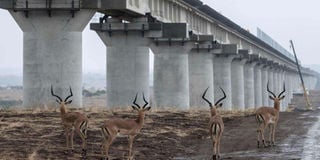It’s a jungle out there as poaching, conflict worsen

Wildlife poaching goes up. PHOTO | FILE | NATION MEDIA GROUP
Wild animals have been photographed in places where they could not go three months ago, roaming and rummaging without care.
Despite the new found ‘peace and tranquility, due to lack of visitors, the animals are more threatened than ever, experts have said.
From increased human-wildlife conflict and encroachment to threats of being poached, it may not be such a ‘field day’ after all.
In an interview with the HealthyNation, Daniel Letoiye, the East African Wildlife Society's head of operation, said conservation efforts had become hard at a time when all attention is directed towards combating the spread of Covid-19.
Conservancies, which occupy 11 per cent of the total land mass in Kenya compared to eight per cent occupied by national parks and reserves, are under great pressure for lack of funding.
In fact, 68 per cent of all the wild animals are found outside protected areas – private ranches and conservancies, which depend directly on the income generated from tourism, but there are no tourists getting into the country due to restrictions imposed by governments to prevent the spread of the deadly disease.
There are 160 conservancies spread across 28 counties and which have employed 3,500 rangers who are now facing an uncertain future. Without measures to combat the effect of the coronavirus disease, all these rangers will be laid off, an action which will leave the wildlife at the mercies of the poachers and unscrupulous businessmen, said Dickson Kaelo, the Kenya Wildlife Conservancies Association CEO.
“The funds available right now can only pay rangers up to June. Unless conservancies have donor funding, most of them (rangers) will have to go home,” he said.
Lewa Conservancy Chief Operating Officer Tuqa Jirmo said the conservancy had already scaled down its operations to stay afloat, but only in the short term because it may not be tenable to pay rangers going forward, if Covid-19 is not controlled and restrictions limited.
Without tourism income, the rangers will not be able to execute grazing plans which will likely collapse and negatively affect wildlife conservation especially during dry months like September. “With the disease spread, we expected increased cases of poaching,” he said.
Cases of human-wildlife conflict, livestock encroachment and poaching of bush meat especially at the Lake Nakuru National Park and the conservancies in Samburu (Lewa), Laikipia and the Tsavo have gone up as people seek to get food and income.
“Since Covid-19 started so many people have been laid off. There are so many people who were working in the flower farms who no longer have a job. When people do not have means they do what they can to stay alive,” said Kaelo.
Due to the floods and decreased activities at the Maasai Mara, there has been human-wildlife conflict.
“Lions cannot hunt in a flood situation and the flooding in Mara has forced them to move out and are now attacking livestock,” he said.
He added that about six people were attacked and killed by elephants around the Amboseli National Park in March and April.
But Covid-19 has presented an opportunity for the government to redesign the tourism model and make resources more available to the community, park authorities and facility owners, said Kaelo.
Kenya receives at least two million tourists per year where tourism generates over Sh150 billion in the same period. According to the conservationists, the government should be able to fund wildlife conservation activities.
During a recent webinar, experts called for the diversification of tourism revenue and creation of a Wildlife Endowment Fund to sustain the sector.


